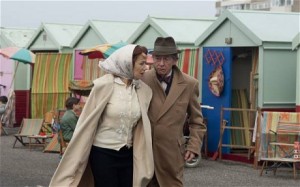Brighton Rock/2010/IFC Films/111 min.
“Brighton Rock” opens with a shot of oil-black ocean waves. Like the moonlit water, the film is beautiful but turgid and at times untamed in the hands of first-time feature film director Rowan Joffe.
Based on a Graham Greene novel, it’s a classic crime story first made into a movie in 1947 with a script by Greene and Terence Rattigan. This time around, Joffe, a scribe whose credits include “The American” and “28 Weeks Later” wrote the screenplay, changing the setting from the 1930s to 1964.
Young, ruthless and 100 percent pure psychopath, Pinkie Brown (Sam Riley) has risen to the top ranks of a gang in Brighton, a seaside resort town (the title is a reference to the souvenir sticks of hard candy sold there). Avenging a betrayal to his gang, Pinkie sets out to kill a man named Fred Hale (Sean Harris), who happens to be friendly with a working-class grande dame, Ida Arnold (Helen Mirren).
Knowing his life is in danger, Hale parries along the pier, looking for a way to escape, and gloms onto a stranger – a shy, frumpy teenage waitress named Rose (Andrea Riseborough). But this just delays the inevitable and soon Hale is dead at Pinkie’s hands. The last person to be seen with Hale, however, is Frank Spicer (Philip Davis), a booze-weary senior member of Pinkie’s gang. And, by chance, Hale, Spicer and Rose are captured by a touristy photographer; Rose gets the claim ticket for the photo.
Though Pinkie’s overarching objective is to join forces with a rival gang led by Colleoni (Andy Serkis), his immediate priority is to nab that claim ticket and seduce Rose in order to keep her quiet. While it’s easy to keep Rose under his thumb, keeping the feisty Ida from investigating Hale’s death proves to be a spot of bother. As the moral driver of the story, Ida stands in contrast with the young couple who ironically cling to their identities as Roman Catholics.
Joffe’s film is gorgeous to look at – stunning cinematography by John Mathieson matched with superb art direction by Paul Ghiradani and Kellie Waugh, especially the slightly surreal scenes at the Cosmopolitan Hotel. And for the first two acts, Joffe creates a darkly moody atmosphere and balances the storylines deftly.
But as the plot progresses, Pinkie’s dealings with Colleoni essentially dissolve as the focus shifts entirely to Pinkie, Rose and Ida. The strange couple seems an awkward transplant to the ’60s – how does the time change serve the storytelling?
Arguably, the fact that Joffe gets compelling performances from an excellent cast (which includes John Hurt and Nonso Anozie) is despite not because of his direction. In particular, he wastes an opportunity with the part of Rose. Despite Riseborough’s capabilities, the character’s tone never varies from a Plain Jane frightened mouse.
John Boulting, the director of the 1947 version (released in the U.S. as “Young Scarface”), made Rose deeper and more nuanced by letting actress Carol Marsh show energy and backbone – and it feels more convincing that a girl with a little edge would be attracted to a cut-throat gangster played wonderfully by Richard Attenborough. Hermione Baddeley also delights as Ida.
Though unsatisfying on some levels, Joffe’s “Brighton Rock,” is tempting eye candy with an entertaining cast.
Photo from the Daily Telegraph











From FNB readers